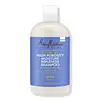What's inside
What's inside
 Key Ingredients
Key Ingredients

No key ingredients
 Benefits
Benefits

 Concerns
Concerns

 Ingredients Side-by-side
Ingredients Side-by-side

Salicylic Acid 3%
MaskingWater
Skin ConditioningSodium Methyl Cocoyl Taurate
CleansingCocamidopropyl Betaine
CleansingGlycerin
HumectantSodium Citrate
BufferingGlycol Distearate
EmollientMelaleuca Alternifolia Leaf Oil
AntioxidantSodium PCA
HumectantLactic Acid
BufferingMenthyl Lactate
MaskingSodium Gluconate
Skin ConditioningPanthenol
Skin ConditioningMentha Piperita Oil
MaskingCaramel
Cosmetic ColorantMaltodextrin
AbsorbentHydrolyzed Gardenia Florida Extract
AntioxidantCharcoal Powder
AbrasiveCocos Nucifera Oil
MaskingBiotin
AntiseborrhoeicHyaluronic Acid
HumectantSalicylic Acid 3%, Water, Sodium Methyl Cocoyl Taurate, Cocamidopropyl Betaine, Glycerin, Sodium Citrate, Glycol Distearate, Melaleuca Alternifolia Leaf Oil, Sodium PCA, Lactic Acid, Menthyl Lactate, Sodium Gluconate, Panthenol, Mentha Piperita Oil, Caramel, Maltodextrin, Hydrolyzed Gardenia Florida Extract, Charcoal Powder, Cocos Nucifera Oil, Biotin, Hyaluronic Acid
Water
Skin ConditioningCocamidopropyl Betaine
CleansingGlycerin
HumectantGlycol Distearate
EmollientSodium Lauroyl Isethionate
CleansingSodium Chloride
MaskingButyrospermum Parkii Butter
Skin ConditioningSchinziophyton Rautanenii Kernel Oil
EmollientSimmondsia Chinensis Seed Oil
EmollientAloe Barbadensis Leaf Juice
Skin ConditioningAdansonia Digitata Seed Oil
EmollientPanthenol
Skin ConditioningCoconut Acid
CleansingPolyquaternium-10
Guar Hydroxypropyltrimonium Chloride
Skin ConditioningStearamidopropyl Dimethylamine
EmulsifyingPEG-150 Distearate
EmulsifyingSodium Methyl Cocoyl Taurate
CleansingCitric Acid
BufferingLaureth-4
EmulsifyingCaprylic Acid
CleansingCapric Acid
CleansingLauric Acid
CleansingSodium Isethionate
CleansingSodium Methyltaurate
Skin ConditioningSodium Acetate
BufferingSodium Phytate
Sodium Benzoate
MaskingCaprylyl Glycol
EmollientParfum
MaskingWater, Cocamidopropyl Betaine, Glycerin, Glycol Distearate, Sodium Lauroyl Isethionate, Sodium Chloride, Butyrospermum Parkii Butter, Schinziophyton Rautanenii Kernel Oil, Simmondsia Chinensis Seed Oil, Aloe Barbadensis Leaf Juice, Adansonia Digitata Seed Oil, Panthenol, Coconut Acid, Polyquaternium-10, Guar Hydroxypropyltrimonium Chloride, Stearamidopropyl Dimethylamine, PEG-150 Distearate, Sodium Methyl Cocoyl Taurate, Citric Acid, Laureth-4, Caprylic Acid, Capric Acid, Lauric Acid, Sodium Isethionate, Sodium Methyltaurate, Sodium Acetate, Sodium Phytate, Sodium Benzoate, Caprylyl Glycol, Parfum
Ingredients Explained
These ingredients are found in both products.
Ingredients higher up in an ingredient list are typically present in a larger amount.
Cocamidopropyl Betaine is a fatty acid created by mixing similar compounds in coconut oil and dimethylaminopropylamine, a compound with two amino groups.
This ingredient is a surfactant and cleanser. It helps gather the dirt, pollutants, and other impurities in your skin to be washed away. It also helps thicken a product and make the texture more creamy.
Being created from coconut oil means Cocamidopropyl Betaine is hydrating for the skin.
While Cocamidopropyl Betaine was believed to be an allergen, a study from 2012 disproved this. It found two compounds in unpure Cocamidopropyl Betaine to be the irritants: aminoamide and 3-dimethylaminopropylamine. High-grade and pure Cocamidopropyl Betaine did not induce allergic reactions during this study.
Learn more about Cocamidopropyl BetaineGlycerin is already naturally found in your skin. It helps moisturize and protect your skin.
A study from 2016 found glycerin to be more effective as a humectant than AHAs and hyaluronic acid.
As a humectant, it helps the skin stay hydrated by pulling moisture to your skin. The low molecular weight of glycerin allows it to pull moisture into the deeper layers of your skin.
Hydrated skin improves your skin barrier; Your skin barrier helps protect against irritants and bacteria.
Glycerin has also been found to have antimicrobial and antiviral properties. Due to these properties, glycerin is often used in wound and burn treatments.
In cosmetics, glycerin is usually derived from plants such as soybean or palm. However, it can also be sourced from animals, such as tallow or animal fat.
This ingredient is organic, colorless, odorless, and non-toxic.
Glycerin is the name for this ingredient in American English. British English uses Glycerol/Glycerine.
Learn more about GlycerinGlycol Distearate serves as a pearlizing or opacifying agent in cosmetic products.
It's often included in cleansers and haircare products to give them a lustrous or shimmering appearance.
It is derived from stearic acid, a natural fatty acid commonly found in vegetable oils and animal fats.
Glycol Distearate isn't fungal acne safe.
Learn more about Glycol DistearatePanthenol is a common ingredient that helps hydrate and soothe the skin. It is found naturally in our skin and hair.
There are two forms of panthenol: D and L.
D-panthenol is also known as dexpanthenol. Most cosmetics use dexpanthenol or a mixture of D and L-panthenol.
Panthenol is famous due to its ability to go deeper into the skin's layers. Using this ingredient has numerous pros (and no cons):
Like hyaluronic acid, panthenol is a humectant. Humectants are able to bind and hold large amounts of water to keep skin hydrated.
This ingredient works well for wound healing. It works by increasing tissue in the wound and helps close open wounds.
Once oxidized, panthenol converts to pantothenic acid. Panthothenic acid is found in all living cells.
This ingredient is also referred to as pro-vitamin B5.
Learn more about PanthenolThis gentle cleansing and foaming ingredient is known for leaving a smooth feeling in skin and hair. It is made using coconut oil.
According to the manufacturer, it is soluble in water and has resistance to hard water, acid, and alkali.
Due to its coconut base, it may not be Malassezia folliculitis safe.
Learn more about Sodium Methyl Cocoyl TaurateWater. It's the most common cosmetic ingredient of all. You'll usually see it at the top of ingredient lists, meaning that it makes up the largest part of the product.
So why is it so popular? Water most often acts as a solvent - this means that it helps dissolve other ingredients into the formulation.
You'll also recognize water as that liquid we all need to stay alive. If you see this, drink a glass of water. Stay hydrated!
Learn more about Water